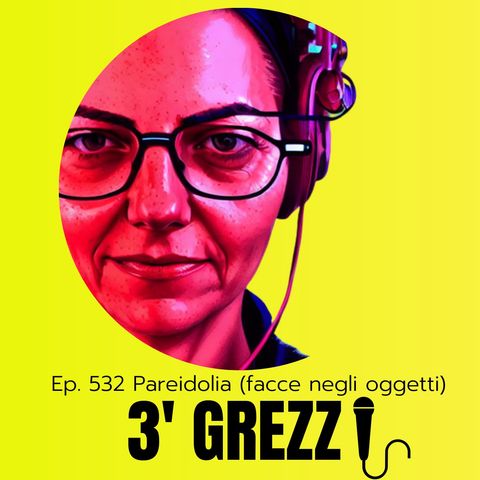3' grezzi Ep. 532 Pareidolia (facce negli oggetti)

Descarga y escucha en cualquier lugar
Descarga tus episodios favoritos y disfrútalos, ¡dondequiera que estés! Regístrate o inicia sesión ahora para acceder a la escucha sin conexión.
Descripción
Scommetto quello che vuoi, se ti guardi intorno c'è un oggetto inanimato che sembra una faccia. TRASCRIZIONE [ENG translation below] Ci scommetto quello che volete, se adesso vi guardate intorno,...
mostra másTRASCRIZIONE [ENG translation below]
Ci scommetto quello che volete, se adesso vi guardate intorno, non importa dove siete, se siete nella vostra stanza, per strada, alla stazione o al supermercato, sono sicura al 100%, se vi guardate intorno, noterete un oggetto che vi sembra una faccia.
Adesso sto guardando la lampada che è nel muro, appesa al muro dietro lo schermo del mio computer, e le due viti che la tengono ferma sembrano gli occhi e il braccio che esce fuori sembra il naso e la bocca.
Perché succede questo? Perché il nostro cervello, che è così furbo, così addestrato a riconoscere le cose, si fa prendere in giro dalle forme inanimate che ci sembrano delle facce? Non è un errore, è una cosa che viene dall'evoluzione, perché per noi il riconoscere i visi è importantissimo.
Infatti, mentre per riconoscere un oggetto impieghiamo un po' di tempo, non mi ricordo se un centesimo o mezzo centesimo di secondo, per riconoscere un viso impieghiamo un decimo di quel tempo. Questo è anche il motivo per cui nelle banconote spesso ci sono dei visi, perché mentre per noi è molto difficile riconoscere le differenze tra due palazzi simili, è invece facilissimo riconoscere le differenze tra due visi quando si conosce il viso.
Pensate quando incontrate una persona che magari non vedete da tempo, o anche una persona che conoscete bene, prima che la persona apra bocca voi sapete già se è contenta, se sta bene, se sta male, se è arrabbiata, anche prima di parlare, perché il nostro cervello è abituato a decifrare un sacco di piccoli segnali che è anche difficile poi descrivere, proprio per una storia dell'evoluzione, perché per noi i visi sono importanti.
Ora questa capacità, capacità non lo so, questo trucco che ci gioca il cervello, che ci fa vedere facce nelle nuvole, nel muro, nelle borse aperte, nel coperchio del water sollevato, ha un nome e si chiama, pareidolia ed è appunto una cosa che ci succede, che ci fa pensare subito... il nostro cervello che si chiede immediatamente ma questa cosa qua è una faccia oppure no? Perché ci comportiamo diversamente in base al fatto che sia o no una faccia, perché se è una faccia vuol dire che è un essere umano.
Questa cosa che è nata come una cosa dell'evoluzione però ha anche altri altri aspetti, ha ramificazioni e cioè aiuta la poesia, perché non c'è niente di più bello che starsene sdraiate su un prato, con un bel sole primaverile o di inizio estate, a guardare le nuvole che ci passano sopra la testa e a vederci lì disegnate le facce delle persone.
TRANSLATION
I'll bet you whatever you want, if you look around now, no matter where you are, whether you're in your room, on the street, at the station or at the supermarket, I'm 100% sure, if you look around, you will notice an object that looks like a face.
Now I am looking at the lamp that is in the wall, hanging on the wall behind my computer screen, and the two screws holding it down look like eyes and the arm coming out looks like the nose and mouth.
Why does this happen? Why does our brain, which is so smart, so trained to recognize things, get fooled by inanimate shapes that look like faces to us? It's not a mistake, it's something that comes from evolution, because face recognition is so important to us.
In fact, while to recognise an object takes us a little while, I don't remember whether a hundredth or half a hundredth of a second, to recognise a face takes a tenth of that time. This is also why there are often faces in the banknotes, because while it is very difficult for us to recognise the differences between two similar buildings, it is very easy for us to recognise the differences between two faces when we know the face.
Think about when you meet a person you may not have seen for a long time, or even a person you know well, before the person opens the mouth you already know if they are happy, if they are okay, if they are hurting, if they are angry, even before they speak, because our brains are used to deciphering a lot of little signals that are also difficult then to describe, just because of a history of evolution, because faces are important to us.
Now this ability, ability... I don't know, this trick that the brain plays on us, that makes us see faces in clouds, in the wall, in open bags, in the lifted toilet lid, has a name and it's called pareidolia and it's actually something that happens to us, that makes us think immediately... our brain immediately wondering, but is this thing here a face or not? Becausey do we behave differently based on whether it is a face or not, because if it is a face it means it is a human being.
This thing that started as a thing of evolution however also has other aspects, it has ramifications and that is it helps poetry, because there is nothing more beautiful than lying on a meadow, with a beautiful spring or early summer sun, watching the clouds pass overhead and seeing people's faces drawn there.
Información
| Autor | M. Cristina Marras |
| Página web | - |
| Etiquetas |
Copyright 2024 - Spreaker Inc. an iHeartMedia Company
